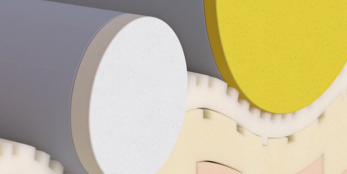Before working with this product, you must read and become familiar with the available information regarding its risks, proper use, and safe handling. This information is provided in various formats, including the current Safety Data Sheet (SDS) and product label. SDS can be accessed via the following link:
Safety Data Sheets (SDS) for Covestro products | Covestro
For further questions, please use the contact information provided on this technical data sheet.
Product description
Hydrophilically modified, aliphatic polyisocyanate based on hexamethylene diisocyanate (HDI).As the hardener/binder component for high-quality waterborne polymer dispersions and as an additive to improve the property level of waterborne coating and adhesive systems.With respect to its composition, the product corresponds to the following sections of the U.S. FDA’s guidelines Title 21 CFR: Section 175.105 “Adhesives”.
Applications
Because of its hydrophilic character, Bayhydur® ultra 304 can be easily emulsified in the aqueous phase.It is used mainly as the crosslinking partner for waterborne polyol binders (Bayhydrol®) and as a crosslinker for largely pH-neutral waterborne polymer dispersions, including polyurethane (Dispercoll® U), polyvinyl acetate, polyacrylate and synthetic rubber dispersions.After addition of Bayhydur® ultra 304, the ready-to-use two-component formulation must be used within the pot life. This is not only governed by the polymer content but also by its other constituents (resin, thickener, plasticizer, etc.). Within many dispersions, the end of this pot life – usually several hours – is not marked by gelling.The addition of 3 – 10 % Bayhydur® ultra 304 is recommended to crosslink adhesive dispersions containing 40 – 60 % polymer. Effective mechanical stirring is required to emulsify Bayhydur® ultra 304 in adhesive dispersions. Manual stirring by hand is not sufficient to ensure good homogenization, especially in the case of low-viscosity adhesive dispersion. Inadequate dispersion may result in the formation of granular deposits in the adhesive.Should Bayhydur® ultra 304 be modified with an additive, this may contain no groups which react with isocyanate and no secondary components which may do so. In particular, any additives used must be free of secondary components which are alkaline or have a catalytic effect on isocyanate groups. Even at very low concentrations, these can cause an increase in viscosity or even solidification.
Specification
| Property | Test Condition | Value | Unit | Standard |
|---|---|---|---|---|
| NCO content | 18,2 ± 0,5 | % | M105-ISO 11909 | |
| Viscosity | at 23 °C | 4,000 ± 1,500 | mPa*s | M014-ISO 3219/A.3 |
| Color value | (Hazen) | ≤ 60 | M017-EN 1557 | |
| Monomeric HDI | < 0,10 | M106-ISO 10283 |
Typical Values
| Property | Test Condition | Value | Unit | Standard |
|---|---|---|---|---|
| Equivalent weight | approx. 230 | |||
| Density | approx. 1,16 | g/ml | DIN 51757 | |
| Flash point | 226 | °C | DIN EN 22719 |
Solubility / thinnability
Generally speaking, Bayhydur® ultra 304 has good compatibility with the solvents listed: esters, ether esters, xylene and solvent naphtha® 100. However, the solubility/compatibility should be tested in each individual case.Only PU grade solvents (< 0.05 % water) should be used.
Storage
- Storage in original sealed Covestro container. - Recommended storage temperature: 0 - 30 °C. - Protect from moisture, heat and foreign material. General information: Hydrophilic isocyanates are very moisture-sensitive and react with water to form carbon dioxide and insoluble ureas. The containers must always be kept tightly closed. The access of water in all forms (moist air, solvents, moist containers) must be prevented, because the generation of carbon dioxide can lead to dangerous increases in pressure. Storage at higher temperatures will result in increase of color and viscosity. Due to the raw materials, the product may show visible turbidity caused by the cold. This turbidity occurs at approx. + 5 °C and is reversible when heated to room temperature. The product properties are not affected.
Storage time
Covestro represents that, for a period of nine months following the day of shipment as stated in the respective transport documents, the product will meet the specifications or values set forth in section "specifications or characteristic data" above, what ever is applicable, provided that the product is stored in full compliance with the storage conditions set forth in and referenced under section "storage" above and is otherwise handled appropriately.The lapse of the nine months period does not necessarily mean that the product no longer meets specifications or the set values. However, prior to using said product, Covestro recommends to test such a product if it still meets the specifications or the set values. Covestro does not make any representation regarding the product after the lapse of the nine months period and Covestro shall not be responsible or liable in any way for the product failing to meet specifications or the set values after the lapse of the nine months period.
Health and Safety Information
Disclaimer
Responsibility and Liability
The use of Covestro products, technical assistance, and information (regardless of how provided) is outside Covestro’s control and is solely the responsibility of the customer. The customer must conduct adequate testing to determine the suitability of products for its intended use, including but not limited to technical, health, safety, and environmental aspects. Unless otherwise agreed in writing, all products are sold exclusively under Covestro’s standard conditions of sale, which prevail in case of conflict and are available upon request.
The terms and conditions of sale and delivery are available via the following link:
https://order.covestro.com/covestrostorefront/saleConditions
All information is provided “as is” without warranties, express or implied, including merchantability or fitness for a particular purpose, and is subject to change without notice. To the maximum extent permitted by law, Covestro disclaims, and the customer assumes all liability for losses, damages, or claims arising out of use of Covestro products, technical assistance, or information. Any statement or recommendation not expressly contained in Covestro documentation is unauthorized and shall not bind Covestro. Nothing herein shall be construed as encouraging or recommending the use of any product in conflict with any claim of any patent. No license is implied or in fact granted under the claims of any patent.
Restrictions on Regulated Applications
This product is not intended for use in regulated applications such as agriculture, cosmetics, drinking water contact, medical products (e.g., medical devices), toys, or similar uses subject to specific regulatory requirements. Prior written approval from Covestro is required before this product may be used in any regulated application. The customer is solely responsible for ensuring compliance with all applicable laws and determining product suitability. Covestro disclaims all liability and warranties for unauthorized regulated uses.
Conditional Use in Regulated Applications
This product may be suitable for use in food contact. However, use in such applications requires prior written approval from Covestro. Legal requirements for such applications vary by country and jurisdiction, and the customer is solely responsible for verifying compliance with all applicable laws and regulations. Without Covestro’s written approval, the product may not be distributed or used for regulated purposes, and Covestro disclaims all liability for such use.
Typical Value
The values provided are typical only and do not represent binding specifications. Unless expressly confirmed in a written contract, these values are not part of the contractual quality agreement and must not be relied upon as a warranty or guarantee of product performance.
Sample
Samples provided by Covestro are intended solely for evaluation and testing purposes by the customer and may not be used in commercial applications, resold, transferred to third parties (except qualified testing service providers acting on behalf of the customer), reverse engineered, modified, or used in any manner not explicitly authorized in writing by Covestro. Samples are provided ‘as-is’ without any warranties, express or implied, including fitness for a particular purpose. Customers are solely responsible for ensuring safe handling, regulatory compliance, and suitability of the material for their intended evaluations. Covestro disclaims all liability for damages or losses arising from the use of samples.
Contact Information
Please use our contact form or contact us directly by sending an e-mail to technical-datasheets@cx.covestro.com .







